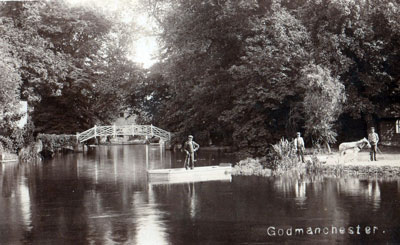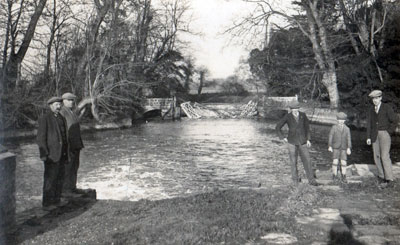When Island Hall was built in the middle of the 18th century there was a vogue for the 'Chinese Chippendale'  and John Jackson, the Receiver General for Huntingdonshire, who built the house, followed the fashion by constructing the bridge in this style.
and John Jackson, the Receiver General for Huntingdonshire, who built the house, followed the fashion by constructing the bridge in this style.
The town's Chinese Bridge which was built in 1827, was inspired by this existing structure when the style became fashionable again at the beginning of the 19th century.
Although certain facts are known about the history of the Island Hall bridge, its exact origins are still a bit of a mystery. The enclosure map of 1803 shows not only the bridge over the Mill Race, but also a second bridge linking the island to what is now the play area.
The first published mention of the “Chinese Bridge" was contained in a notice in the Cambridge Chronicle, dated 31 March 1804 announcing that Island Hall was to be sold by auction:
"Kitchen and Flower Gardens adjoining, encompassed by lofty walls: a delightful Island of Pleasure Ground, of about 2 acres, surrounded by the navigable River Ouse, communicating with the Flower Garden by a Chinese Bridge, and beautifully interspersed with Grovage, Fish Ponds, Walks and Fruit Trees”.
Octavia Hill, one of the founders of the National Trust, described the house and garden when writing to her sister, Emily, whilst staying at Island Hall on 15th October 1859:
"The garden is not large, it consists of a glorious lawn of smooth bright green grass, a few brilliant flower borders, and a long bright old brick wall, a small cedar on the lawn, but it is bounded at the bottom by the Ouse, a deep clear stream, across which is a pretty bridge leading to an embowered island, belonging to this house, a water mill is above."
Some modifications to the structure took place when two 19th century brick arches were inserted between the original piers, possibly to replace wooden arches. Wooden steps are also shown in a photograph taken in about 1890. The late Victorians/Edwardians then installed ramps to enable them to transport their horse-drawn lawnmower over the bridge; an Edwardian photograph of 1902 shows two of General Baumgartner's children fishing off these ramps.
We also know that some restoration was carried out in 1912. Then, during a weekend storm on 23rd November 1928, one of the island's romantically arched Huntingdon elms fell across the central span of the bridge, as shown in the Witney photograph. Another photograph of drought conditions during the thirties shows the re-erected bridge reduced to a flat, solid repair exercise, losing the camber which gave the bridge such elegance and strength. During the following years, through the second World War, and throughout the fifties and sixties when the Borough Council were responsible for the bridge's upkeep, no maintenance was carried out. So, sadly, in 1972 the bridge was destroyed when it was in an advanced state of decay.
Following the reclaiming of their family home in 1983, Christopher and Linda Vane Percy embarked on a project in May 1986 to replace the Chinese Bridge, re-linking the garden with its ornamental island.
The actual design of the replica was a fascinating study, including the use of numerous photographs from the Edwardian period up until the forties. The aim was to replicate as closely as possible the bridge as it was in the 1902 photograph, (partly so that Christopher Vane Percy could, as did his ancestors, transport his mowing equipment to the island)
Photographic evidence was extremely important, otherwise many details would have been lost. The most useful pictures were the “box brownie' snaps of informal groups which gave more close up details. Fortunately everyone liked to be photographed on the bridge
It was also lucky that the last of the two brick arches, which survived until the spring of 1985, had been surveyed prior to its collapse. During the Edwardian restoration of the bridge extensive repointing had taken place and, rather like an archaeological dig, the impressions of the timber were left outlined on the cement. From this sort of evidence we were able to ascertain the exact sizes of some of the timbers, thereby having a scale to work by. Christopher Vane Percy even dredged some original, perfectly preserved, timber from the mud which was a very exciting exercise although not quite of the scale of some of the historic shipwrecks which have been resurrected
Acquiring all this information enabled the drawings of an accurate design to be carried out by Christopher Vane Percy's design company, CVP Designs Limited. The operation was long and complicated as it had to be taken step by step. Before the first part of the reconstruction, the brick work was carried out by Alan Smith Limited of St Neots in 1987. The second stage, the timber work, was carried out by Coulsons of Cambridge, and installed at the end of April, 1988.
The re-building of the bridge, uniting the island with the house, has enhanced this highly visual and historic part of the local conservation area for future generations. Some of the older members of the community, who had known the original bridge, likened it to seeing an old friend who was not expected to return.
No grants were received for the new bridge as it was classed a reinstatement rather than a restoration project. The finished result, however, apart from generating tremendous enthusiasm from both young and old, has received a Conservation Award from the District Council in 1988, the Environmental Trophy from the Rotary Club in 1989, and the 1989 Cambridge Association of Architects Craftsmanship Award.
Christopher Vane Percy